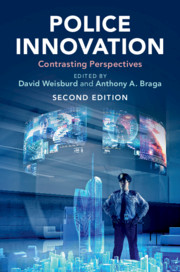Book contents
- Police Innovation
- Police Innovation
- Copyright page
- Contents
- Figures
- Tables
- Notes on Contributors
- Introduction
- Part I Community Policing
- Part II Procedural Justice Policing
- Part III Broken Windows Policing
- Part IV Problem–Oriented Policing
- Part V Pulling Levers (Focused Deterrence) Policing
- Part VI Third–Party Policing
- Part VII Hot Spots Policing
- Part VIII Predictive Policing
- Part IX CompStat
- Part X Evidence-Based/ Risk-Focused Policing
- Part XI Technology Policing
- Index
- References
Part IV - Problem–Oriented Policing
Published online by Cambridge University Press: 09 August 2019
- Police Innovation
- Police Innovation
- Copyright page
- Contents
- Figures
- Tables
- Notes on Contributors
- Introduction
- Part I Community Policing
- Part II Procedural Justice Policing
- Part III Broken Windows Policing
- Part IV Problem–Oriented Policing
- Part V Pulling Levers (Focused Deterrence) Policing
- Part VI Third–Party Policing
- Part VII Hot Spots Policing
- Part VIII Predictive Policing
- Part IX CompStat
- Part X Evidence-Based/ Risk-Focused Policing
- Part XI Technology Policing
- Index
- References
Summary
Why would a hospital have such a policy? This is question Herman Goldstein (1979) asked, but he asked it of policing. His answer was that, “All bureaucracies risk becoming preoccupied with running their organizations and getting so involved in their method of operating that they lose sight of the primary purposes for which they were created. The police seem unusually susceptible to this phenomenon” (1979: 236–237). He called this phenomenon the “means over ends syndrome” (p. 238). Although Goldstein gave numerous examples of the means over ends syndrome in policing, he emphasized the overuse of law enforcement, particularly arrests and the use of the criminal justice system. The law, and its enforcement, are tools to solve problems, according to Goldstein. They are not ends in themselves. They are one of numerous means for accomplishing something greater. Enforcing the law should no more define policing than the claw hammer defines carpenters, the toilet plunger defines plumbers, the drafting table defines architects, or Power Point slides define college professors.
- Type
- Chapter
- Information
- Police InnovationContrasting Perspectives, pp. 163 - 202Publisher: Cambridge University PressPrint publication year: 2019

